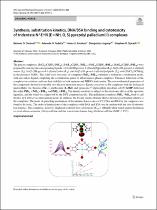| dc.contributor.author | Fadaka, Adewale O | |
| dc.contributor.author | Omondi, Reinner O | |
| dc.contributor.author | Fatokun, Amos A | |
| dc.date.accessioned | 2022-12-05T10:55:14Z | |
| dc.date.available | 2022-12-05T10:55:14Z | |
| dc.date.issued | 2022 | |
| dc.identifier.citation | Omondi, R.O., Fadaka, A.O., Fatokun, A.A. et al. Synthesis, substitution kinetics, DNA/BSA binding and cytotoxicity of tridentate N^E^N (E = NH, O, S) pyrazolyl palladium(II) complexes. J Biol Inorg Chem 27, 653–664 (2022). https://doi.org/10.1007/s00775-022-01959-y | en_US |
| dc.identifier.uri | https://doi.org/10.1007/s00775-022-01959-y | |
| dc.identifier.uri | http://hdl.handle.net/10566/8232 | |
| dc.description.abstract | The pincer complexes, [Pd(L1)Cl]BF4 (PdL1), [Pd(L2)Cl]BF4 (PdL2), [Pd(L3)Cl]BF4 (PdL3), [Pd(L4)Cl]BF4 (PdL4) were prepared by reacting the corresponding ligands, 2,6-bis[(1H-pyrazol-1-yl)methyl]pyridine (L1), bis[2-(1H-pyrazol-1-yl)ethyl]amine (L2), bis[2-(1H-pyrazol-1-yl)ethyl]ether (L3), and bis[2-(1H-prazol-1-yl)ethyl]sulphide (L4) with [PdCl2(NCMe)]2 in the presence NaBF4. The solid‐state structures of complexes PdL1–PdL4 confirmed a tridentate coordination mode, with one chloro ligand completing the coordination sphere to afford square-planar complexes. Chemical behaviour of the complexes in solution confirms their stability in both aqueous and DMSO stock media. The electrochemical properties of the compounds showed irreversible two-electron reduction process. Kinetic reactivity of Pd complexes with the biological nucleophiles viz, thiourea (Tu), L-methionine (L-Met) and guanosine 5′-diphosphate disodium salt (5’-GMP) followed the order: PdL2 < PdL3 < PdL4, and PdL2 < PdL1. The kinetic reactivity is subject to the electronic effects of the spectator ligand(s), and the trend was supported by the DFT computed results. The palladium complexes PdL1–PdL4 bind to calf thymus (CT-DNA) via intercalation mode. In addition, the bovine serum albumin (BSA) showed good binding affinity to the complexes. The mode of quenching mechanism of the intrinsic fluorescence of CT-DNA and BSA by the complexes was found to be static. The order of interactions of the complexes with DNA and BSA was in tandem with the rate of substitution kinetics. The complexes, however, displayed relatively low cytotoxicity (IC50 > 100 µM) when tested against the human cervical adenocarcinoma (HeLa) cell line and the transformed human lung fibroblast cell line (MRC-5 SV2). | en_US |
| dc.language.iso | en | en_US |
| dc.publisher | SpringerLink | en_US |
| dc.subject | Palladium complexes | en_US |
| dc.subject | Kinetic reactivity | en_US |
| dc.subject | DNA and BSA interactions | en_US |
| dc.title | Synthesis, substitution kinetics, DNA/BSA binding and cytotoxicity of tridentate N^E^N (E = NH, O, S) pyrazolyl palladium(II) complexes | en_US |
| dc.type | Article | en_US |

